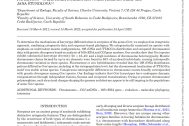Obsah
To determine the mechanisms of karyotype differentiation in scorpions of the genus Gint, we employed an integrative approach, combining cytogenetic data and sequence-based phylogeny. We cytogenetically examined six species with emphasis on multivalent meiotic configurations, 18S rDNA and (TTAGG)n distribution and compared chromosomal data with genetic divergence based on analysis of 16S rRNA and COI gene markers. Our results show that Gint species exhibit substantial karyotype diversity (2n = 18–45) and a high incidence of chromosome heterozygosity. Meiotic chromosome chains formed by up to six elements were found in 85% of analysed individuals, causing intraspecific chromosome variation in three species. Fluorescence in situ hybridization revealed that the 18S rDNA distribution pattern differed in Gint species, including at the intrapopulation level, but the chromosomal localization of (TTAGG) motif was stable across species. Conspicuous interspecific differences in chromosome counts broadly corresponded with genetic divergence among Gint species. Our findings indicate that Gint karyotypes have undergone dynamic reorganization through independent fusions, fissions and reciprocal translocations. Owing to present chromosomal polymorphism, such structural changes shaping the genome architecture appear to be still ongoing in the populations of some Gint species.



